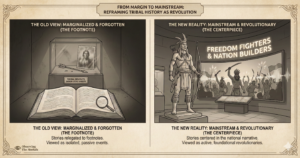Imagine a society with nearly a quarter of a million people, spread across a vast territory, but with no kings, no chiefs, no police, and no formal laws. By the logic of modern political science, this should be a recipe for chaos—a war of all against all. Yet, when the renowned British anthropologist E.E. Evans-Pritchard studied such a society in the 1930s, he found not chaos, but a complex and ingenious system of political order. This case study delves into his landmark work on the Nuer of South Sudan, a people who mastered the art of creating governance without a government.
The Information Box
Syllabus Connection:
- Paper 1: Chapter 4 (Political Anthropology: Stateless Political Systems), Chapter 2.4 (Kinship), Chapter 6 (Anthropological Theories: Structural-Functionalism)
Key Concepts/Tags:
- Segmentary Lineage, Ordered Anarchy, E.E. Evans-Pritchard, The Nuer, Stateless Society, Political Anthropology
The Setting: Who, What, Where?
This is the world of Sir E.E. Evans-Pritchard, a towering figure of British Social Anthropology. His 1940 monograph, The Nuer, is based on his extensive fieldwork among the Nuer people, a pastoralist community inhabiting the swamps and savannahs of what is now South Sudan. The Nuer presented a puzzle: they were a large and often warlike society but lacked any form of centralized political authority.
The Core Argument: Why This Study Matters
Evans-Pritchard’s central achievement was to solve the puzzle of this “ordered anarchy.” He argued that the Nuer political system, while invisible to the untrained eye, was very real and was based entirely on their kinship structure.
- The Segmentary Lineage System: The secret to Nuer political life was their segmentary lineage system. Every Nuer man belongs to a patrilineage, and these lineages are nested within each other like Russian dolls or the branches of a tree. A small, minimal lineage is part of a larger minor lineage, which is part of a major lineage, which in turn is part of a clan. While a man’s primary loyalty is to his closest relatives, he can activate these wider kinship ties when needed.
- The Principle of “Balanced Opposition”: This is the dynamic that brings the system to life. The level of political cooperation depends entirely on the level of the conflict. The Nuer have a famous proverb that explains this perfectly: “I and my brother against my half-brother; I and my brothers and half-brothers against our father’s brothers; our lineage against another lineage; our clan against another clan.”
- How It Works (Structural Relativity): If a man from lineage X gets into a dispute with a man from lineage Y (both part of the same larger clan Z), all of lineage X will unite against all of lineage Y. However, if someone from an entirely different tribe attacks anyone from clan Z, then lineages X and Y will instantly forget their internal quarrel and unite as clan Z to fight the common enemy. This flexible system allowed the Nuer to function as a small, feuding group one day and as a large, unified army the next, all without a single chief to give orders.
The Anthropologist’s Gaze: A Critical Perspective
- An Overly Neat Model?: Later anthropologists have questioned whether the segmentary lineage system worked as perfectly on the ground as Evans-Pritchard’s elegant model suggests. Reality is often messier, and his work has been critiqued for presenting an idealized and overly formal structure of Nuer society.
- Ignoring Other Factors: By placing such a heavy emphasis on kinship (lineage) as the sole basis of political life, Evans-Pritchard’s analysis might have downplayed other important factors like economic ties, territorial loyalties, or the influence of charismatic individuals (prophets) in Nuer society.
- The Colonial Context: Evans-Pritchard was conducting his research as an officer of the British colonial administration in Sudan. Critics have argued that this context is crucial. Was he creating a model of Nuer society that would help the British understand and therefore control a famously rebellious people? This “anthropology-as-tool-of-colonialism” critique is an important layer to consider.
The Exam Angle: How to Use This in Your Mains Answer
- Types of Questions Where It Can Be Used:
- “What do you understand by a stateless political system? Explain with ethnographic examples.”
- “Discuss the political functions of lineage and kinship in tribal societies.”
- “Critically evaluate the contributions of the structural-functionalist school in anthropology.”
- Model Integration:
- On Stateless Societies: “The classic example of a stateless political system is the Nuer of South Sudan, as studied by E.E. Evans-Pritchard. He demonstrated how their segmentary lineage system provided a framework for large-scale political mobilization and social order in the complete absence of a centralized state.”
- On Kinship’s Political Role: “Kinship is not merely for social reproduction; it can be the primary basis of political life. In the Nuer’s segmentary lineage system, the principle of ‘balanced opposition’ dictates that the scope of political alliance expands or contracts depending on the level of conflict, turning kin groups into flexible political units.”
- To offer a critique: “While Evans-Pritchard’s model of the Nuer is foundational to political anthropology, it has been critiqued for being an idealized representation that perhaps understates the role of economic and territorial factors in favor of a purely lineage-based structure.”
Observer’s Take
Evans-Pritchard’s work on the Nuer was revolutionary because it forced the Western world to recognize that “no government” does not mean “no governance.” He uncovered the hidden political genius in a society that, to an outsider, might have looked like simple anarchy. The Nuer became the textbook case for how human beings can create vast, complex, and effective political systems through the logic of kinship alone. His study is a masterclass in looking past our own assumptions about what is necessary for social order and discovering the intricate, and often invisible, structures that hold all human societies together.




